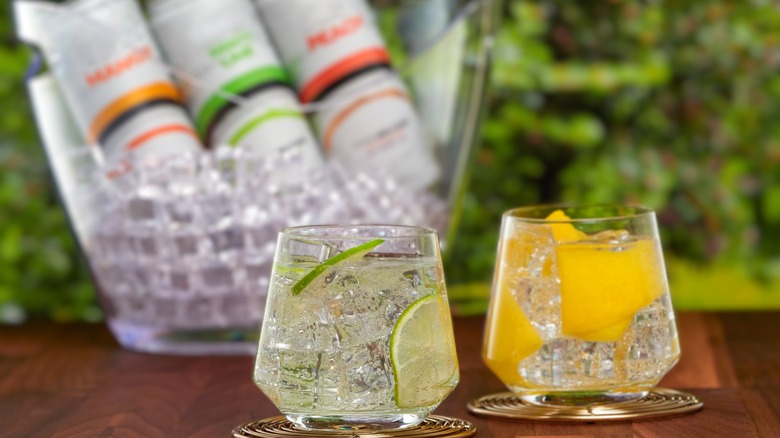Hard Seltzers Have Been Around A Lot Longer Than White Claw
When it comes to hard seltzers, White Claw is king. It was the brand that broke through the market in 2016 and has continued to hold strong with an estimated market share above 50% by 2023. The summer sipper may not be the best-tasting hard seltzer currently available (White Claw Surge landed near the bottom of our hard seltzer ranking), but that hasn't kept it from being the best performing. Like every good overnight success story, the explosive onset of hard seltzers was years in the making.
The very first hard seltzer is credited to Zima, a clear malt beverage first produced by Coors in 1993. It didn't taste much like the hard seltzers we know today though. Zima was born out of the health-conscious clear craze of the '80s and '90s that gave us Crystal Pepsi, clear dish soap, and transparent Game Boys. Zima was made by filtering the color out of cheap lager with charcoal before adding lemon-lime flavoring to it to make up for the filtered-out taste.
Coors was onto something, but the marketing team missed the mark. Zima was heavily marketed to athletes looking for a healthy alternative to regular beer. What the team didn't realize was that the target audience should have been women looking for a lighter drink at the bar. In any case, the women found Zima anyway, the drink was relatively successful for a time. Unfortunately, the fad didn't stick. Although Zima stayed on the shelves until 2008, its popularity was already in decline by 1996.
Humble beginnings
Coors wasn't the only company looking to cash in on clear beer. Miller Brewing Company came out with Miller Clear shortly after Zima, but Zima had apparently eaten up what market interest there was in a clear beer product because it didn't perform well. It probably didn't help that neither of these drinks are remembered as tasting good. If anything, Zima and Miller Clear were perfect signs that there was a public interest in something like hard seltzers — so long as people enjoyed the taste.
Then in 2012, upstart entrepreneur Nick Shields created Spiked Seltzer out of his garage. Spiked Seltzer would go on to become the more widely known Bon & Viv seltzer brand after it was sold to AB InBev in 2016, which was around the time that White Claw was just starting up. Sales were initially good for these types of hard seltzers, but 2019 is known as the year that the genre really took off.
Hindsight is a wonderful thing but it obfuscates what it must have felt like in the moment. Hard seltzers didn't exist yet, but companies understood that there was a gap in the market for a light drink that had a similar alcohol content to beer. Keep in mind that hard seltzers are not the same thing as beer even if they are also classified as malt beverages. There's no malt in hard seltzers, just sugar, water, yeast, and flavorings. Without the clear beer experiment, it's hard to say if hard seltzer would exist today.

